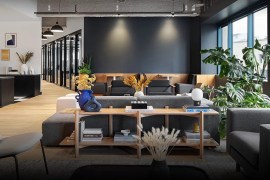The New York Times recently reported on a notable trend rising in luxury rental buildings: Developers are adding professional work and creative spaces to new developments across the country.
A survey released earlier this year by the Pew Research Center showed some of the ways in which the COVID-19 pandemic continues to reshape work in the current economy. Specifically, most of the teleworkers that were sent out of offices in early 2020 have stated that they would prefer to continue to work remotely. What’s more, the survey found that the percent of remote workers expressing the preference to maintain this flexibility has increased from 64% in 2020 to 78% at the start of this year.
This transformational workplace movement has not gone unnoticed by developers, who are already getting creative in responding to the rising work-from-home space priority of prospective residents.
In its report, The New York Times illustrated the case with a reference to the Willoughby, a 34-story high-rise that recently opened in downtown Brooklyn. Project developer RXR Realty has successfully attracted tenants with an essential amenity: A tastefully designed coworking space on the 22nd floor that includes semi-private banquettes, access to a landscaped terrace, and a conference room with a great view.
Upgrading Urban Homes to the Needs of the Knowledge & Creative Economy
The race to stay ahead of residents’ modern convenience needs has resulted in luxury rental buildings and condos incorporating amenities such as private offices, conference rooms, wall-mounted monitors, task lighting, podcasting booths and high-speed internet.
Ric Campo, chief executive and chairman of Camden Property Trust, aptly captured the essence of the current trend in a statement to The New York Times: “It’s something you have to do today. It’s an amenity, like a pool.”
Camden Property Trust also included a shared workspace in the common area at Camden Harbor View, the Trust’s residential development in Long Beach, Calif. The Hub, as it was named, is a community workspace that offers high-speed WiFi and cloud printing.
Thomas LaSalvia, senior economist at Moody’s Analytics, noted that such a model could go a long way toward serving high-density communities much closer to home.
“It doesn’t have to be the residents of that apartment building using that space,” he said. “It could be neighbors.”
Established coworking space providers have also taken notice of this new avenue of expansion and are working on partnerships with property managers and developers that are looking to integrate high-quality coworking space in their apartment communities. Jamie Hodari — chief executive and co-founder of Industrious, a workplace provider that has 150 locations in 65 cities worldwide — has recognized the advantages of such an arrangement and stated that the company is close to finalizing a similar deal.
“There are starting to be developers that want to create a complex that services the tenants and the outside world,” he said.
As an example, Hodari mentioned AvalonBay Communities, a real estate investment trust that owns a stake in nearly 300 apartment communities. The trust has set up a brand called Second Space Work Suites, which rents private workspaces on the ground floor of apartment complexes to both residents and the general public.
Meeting Professionals Closer to Home Can Strengthen Local Economies, One Community at a Time
This new amenity trend fills a long-awaited need for a practical workplace solution between the home and the traditional office. Plus, benefits of this “third space” go beyond just having a place to take work calls and set up a quick meeting. For instance, Matt Vance, senior economist with CBRE, noted that, since the start of the pandemic, the average size of new apartments had increased nearly 10% compared to residential deliveries made in the 10 years prior — an increase primarily seen in a work area within the home.
With access to professionally designed workspaces in the building, prospective tenants can reevaluate how much room they need in the home to accommodate a flexible work arrangement. Moreover, a coworking space or meeting room within walking distance in the same neighborhood can also help residents cut other monthly costs, including what used to be daily transportation and dining out in more expensive areas of the city. And, a well-distributed network of coworking space amenities in residential properties can also go a long way to sustaining a strong community spirit and supporting an economic environment in which a diverse multitude of small businesses can grow in service of their respective communities.







